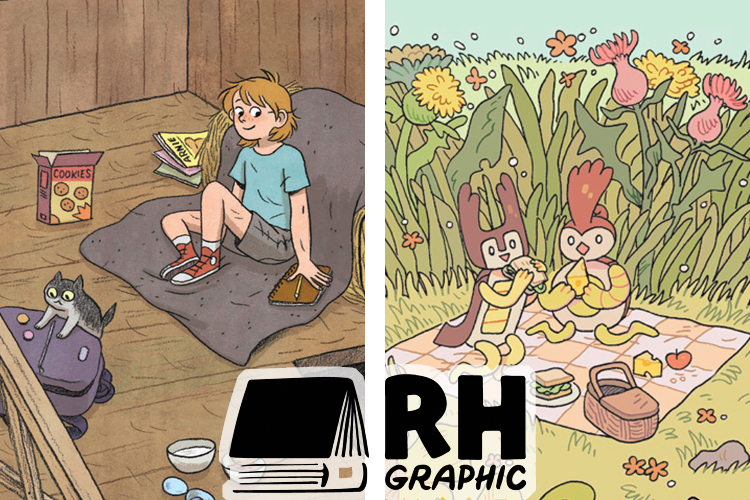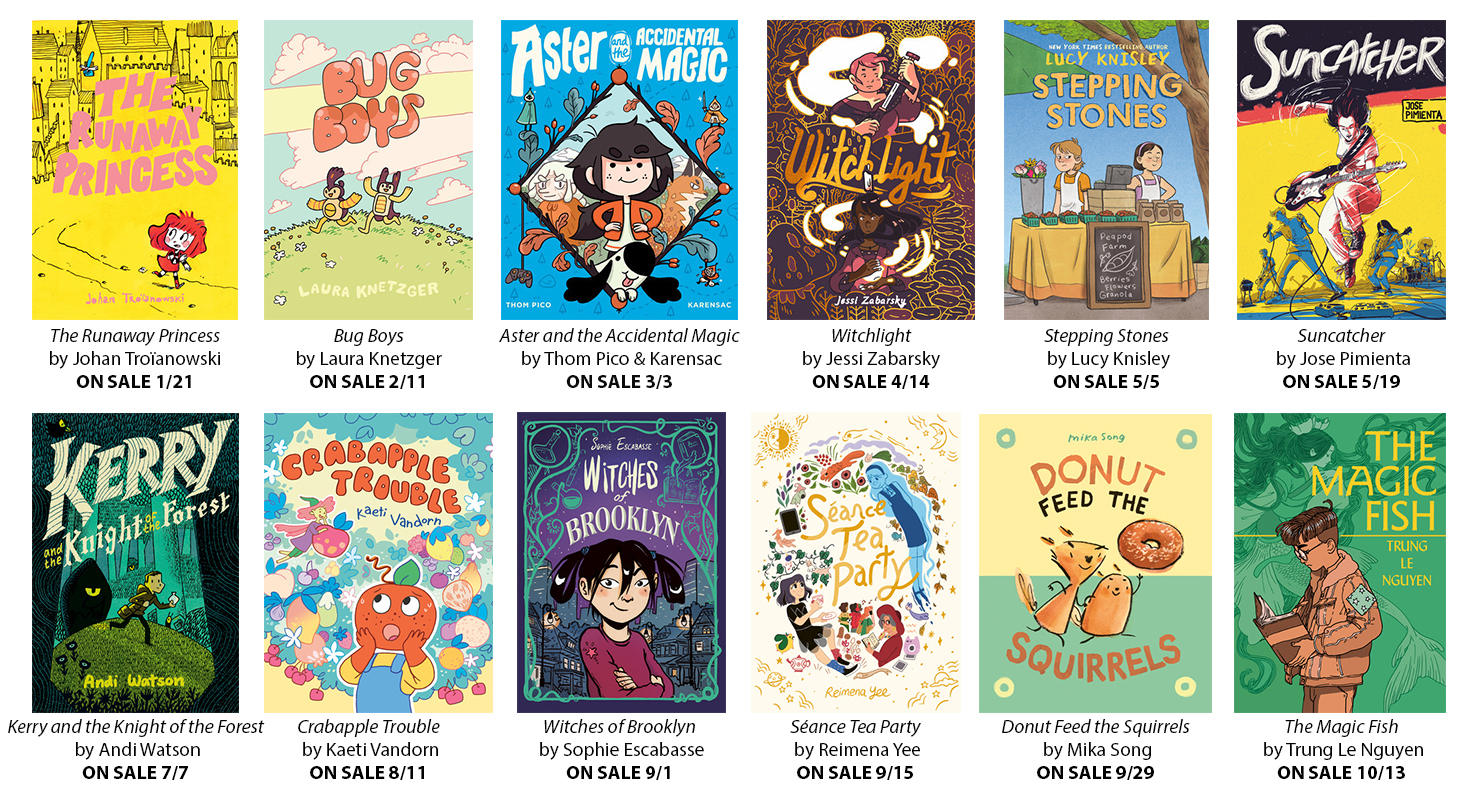
Get the latest updates in your inbox and sign up for more info!
Gina Gagliano has worked at First Second Books since before its opening, and she’s now publishing director at Random House Graphic, the new division of Random House dedicated to graphic novels for children and young readers. In this interview we explore her insight on the birth of this new division and on the current state of the market.
Children’s comic books are the rising stars of the comic book industry right now, an industry that seems to me to have been more focused on the past years on comics and graphic novels meant for an adult readership.
What are the causes of the current explosion in young readers comic books market?
You’re right when you say there’s been an explosion of readers in the graphic novel market! It’s amazing. There have been a lot of publishers, authors, teachers, librarians, and booksellers who have been working tirelessly for over a decade (and in many cases much longer) to bring about the current state of the market.
Prior to 2005, the comics market [in the US. nda] was dominated by superheroes and manga. The introduction of Scholastic Graphix and First Second into the market has changed that over the past fifteen years; their kids comics publishing strategy that centers the books marketplace has brought the industry to where it is today – a point where it seems like every kid, everywhere, is reading graphic novels.
This year, the Bologna Children’s Book Fair decided to establish a Comics Corner, confirming the importance of this market on the grandest scale of children’s literature tout-court. What do you think of this decision? What do you think the impact of comic books and graphic novels for children and young readers will be on the literature market?
I think the Comics Corner is great news! One of the reasons that I think that graphic novels are super is because they can appeal to readers who prefer to read visually, or who learn visually. I love reading prose – but there are people out there who don’t connect with the medium in the same way that I do. Graphic novels, with their combination of text and art, give publishers the opportunity to connect to readers who read differently.
Following up the previous question, do you think this kind of comic books will have more impact (commercially, but also culturally) on the literature market or on the more specific comic book industry? Do you imagine children’s comic books will be perceived more as a segment of the children’s literature market or as a segment of the comic book market?
We’re already seeing the impact of kids comics on both the books market and the comics market. On the books side, with the rise of graphic novels, alongside growth in kids graphic novel publishing, we’re seeing more and more publishers embrace illustrations in books for kids older than picture book age – hence the rise of illustrated middle grade novels. We’re seeing libraries expand their sections, and booksellers start expanding and breaking out kids graphic novel sections into MG and YA.
On the comics market, with the rise of kids graphic novels, we’re seeing an expansion of the creator-owned graphic novel, as more and more books in that category are being published. As the kids industry finds success with diverse graphic novels, we’re also seeing more authors who are women, queer, and POC across the industry. Comic book stores are realigning their focus to include kids comics, to spotlight creator-owned work, and to be more inclusive.
You are currently head of Random House Graphic, an imprint of Random House Children’s Books entirely dedicated to young readers. Can you tell us how the project began and what the work is like to open a brand-new division like this?
Random House Children’s Books was one of the first-ever kids graphic novel publishers in the market, kicking off their Babymouse series by Jennifer L. Holm and Matthew Holm in 2005. Over the years, they’ve published great graphic novels like Lunch Lady, by Jarrett Krosoczka, 5 Worlds, by Mark Siegel, Alexis Siegel, Xanthe Bouma, Matt Rockefeller, and Boya Sun, and Hilo, by Judd Winick. With the increased success of kids graphic novels in the market, the Deputy Publisher of RHCB, Judith Haut, approached me to start a dedicated imprint, Random House Graphic.
Working at a brand-new division – especially one that publishes graphic novels, which are labor-intensive and require different systems than either prose or picture books – is a challenge every day. And it’s exciting every day. What’s really essential is the great team behind Random House Graphic, with Whitney Leopard handling the editorial side of things, Patrick Crotty on design, and Nicole Valdez tackling marketing and publicity.
Did young readers’ comic books gain a new legitimacy in its recent explosion? Are they, for instance, more accepted in schools than they were before?
As graphic novels get awards, become best-sellers, and are acclaimed within the industry and broadly by readers, they become more legitimate.
Starting with Maus winning the Pulitzer Prize in 1992, American Born Chinese winning the Printz Award in 2007, This One Summer winning a Caldecott Honor in 2015, El Deafo winning a Newbery Honor in 2015 and Rollergirl in 2016, March winning a National Book Award in 2016, and New Kid winning the Newbery Medal in 2020, graphic novels have been on the road to widespread acceptance in schools and libraries across the country.
Random House Graphic’s catalogue seems to be very diverse and dedicated to a broad audience in terms of age spectrum, varying from very early readers to young adults. How do you work on such a catalogue? What are the main traits you look for in a comic for this age range?
Most publishers in children’s books work on books for a variety of age ranges, so graphic novels aren’t too different on that front! We take care to clearly identify the audience that we’re publishing each book for when we approach editorial, design, and marketing.
Across all the age categories, we look for strong stories, striking and accessible artwork, and character-focused stories. And because we do aim to have a catalog with a lot of breadth – our motto is “a graphic novel on every bookshelf” – we look for stories that feature characters from many different backgrounds, as well as books across all genres, from fantasy to mystery to nonfiction.
Since Random House Graphic is a relatively new imprint, but with a rich catalogue already, can you tell us something about your favourite and/or strongest titles so far? And, if you can, could you tell us a bit about some upcoming titles?
We have so much in store with Random House Graphic! On the youngest end of our list, for readers ages 4-7, we have books out this year like Stephen Shaksan’s Pizza and Taco: Who’s The Best (a competition for the ages), Kaeti Vandorn’s Crabapple Trouble (a story about dealing with pressure from friends and anxiety), Mika Song’s Donut Feed the Squirrels (a food truck heist caper with the most loveable team of protagonists), and Brian Yanish’s Shark and Bot (friends don’t get any less alike than these two!).
In the 7-10 age category, we have an exciting series launch this year: John Gallagher’s Max Meow. This epic cat-focused action-adventure tale is complemented by our three-volume Bug Boys series, by Laura Knetzger, which features beetles, spiders, dragonflies, and friendship, and J.C. Phillipps’ Pacey Packer, Unicorn Tracker, in which the unicorns are not as nice as expected.
For middle graders, we’ve got everything from witches (featured in Sophie Escabasse’s Witches of Brooklyn) to coming of age (featured in Reimena Yee’s Séance Tea Party) to fantasy adventure (featured in Andi Watson’s Kerry and the Knight of the Forest) to contemporary family stories (featured in Lucy Knisley’s Stepping Stones). Our middle grade books are story and character-focused, and we’re got more great characters to come (like Colleen AF Venable and Stephanie Yue’s Katie the Cat-Sitter, who you’ll be getting to meet next year).
We’re excited to have three YA debut authors this year: Jessi Zabarsky, Jose Pimienta, and Trung Le Nguyen. Trung’s book, The Magic Fish, comes out this Fall — a captivating story of family, fairy tales and the difficulty of coming out when your parents are immigrants and you don’t speak the same language. It’s a Book Expo YA Buzz title this year. Set in a fantasy world, Jessi’s Witchlight features two young women figuring out who they are (and falling in love). Jose’s Suncatcher is more contemporary, with a girl in Mexicali who has to figure out how to balance being passionate about music and her every-day life.
We’re excited to be introducing so many debut graphic novelists – and starting next year, you’ll be seeing some graphic novel nonfiction from us as well.

What are the facets of the comic book language that make it so crucial for children? What is their pedagogic value, in terms of shaping a new generation of readers? In this sense, do you feel some responsibility in the choice you make as a publisher, especially when targeting very young children?
Pictures are really fun! That’s a simplistic answer to the question of pedagogic value, but I honestly feel that more kids will read books if they think books are fun, and pictures are a great place to start on that front. (I’m also of the opinion that more books should be fun – there are a lot of books out there that are very serious, which is great! But I love humour and action-adventure as well as works that have a greater literary value).
Part of being a publisher is figuring out what you want to be communicating to today’s kids, and to the next generation of readers. For us, as a graphic novel imprint, one of those things is, “graphic novels are awesome!”. But like any publisher, we also look very closely at the kinds of stories that we’re telling, to make sure we’re reaching kids in the best possible way, reflecting the diversity of the world around us.
Before Random House you did an incredible job at First Second, a publisher that seems to me guided if not catalysed the early expansion in young reader’s comics. Can you tell us something on your time spent working in First Second, and on what impact you think it has had on the industry?
I started working at First Second in 2005, six months before the imprint published its first book. Getting to work there in the imprint’s formative years was a wonderful experience; their staff is passionate and dedicated, and they publish fantastic books by marvellous authors. Their continued commitment to publishing high-quality books across age categories has made possible much of the growth we see in the industry today.
For more information on Random House Graphic or other graphic novel titles from Random House Children’s Books U.S. referenced here, please contact Jocelyn Lange, Director of International Rights, at jlange@penguinrandomhouse.com
This post is part of a series of interviews to some of the most interesting international publishers specialized in comic books and graphic novel for children and young readers, made in collaboration with BilBOlbul, International Comic Book Festival (curated by Hamelin Associazione Culturale).